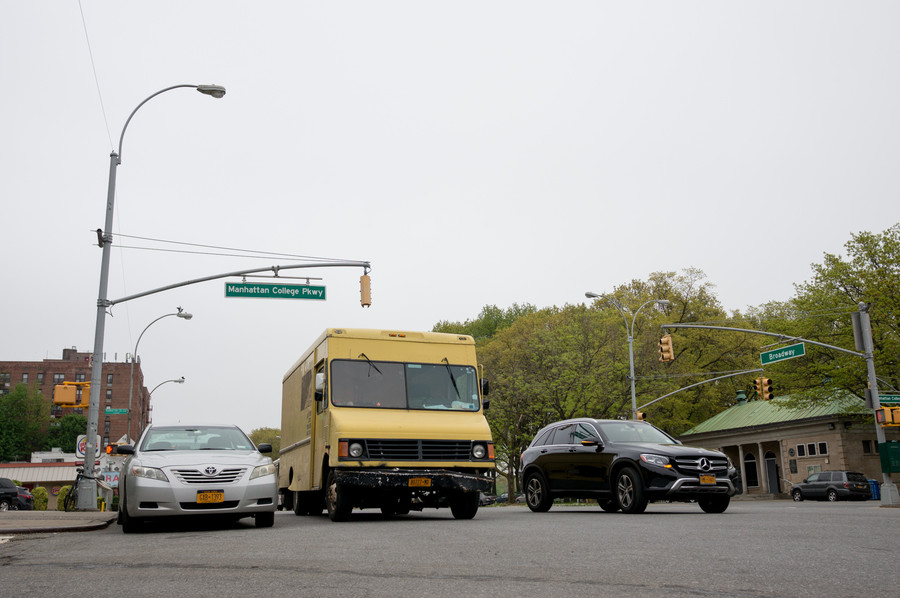Broadway plan hits a bump in the road
The city’s transportation department threw out a lot of facts and figures last week, in its plan to restructure traffic on Broadway, but one figure seemed to stick out.
Twelve.
That’s the number of people who died or were seriously injured on Broadway —10 of who were pedestrians — during a four-year period between 2010 and 2014.
Another person died in 2015, transportation officials said. And the 12th was late last year, when a pedestrian was killed crossing the street at an intersection where the transportation department had installed but not yet turned on a traffic light designed to prevent exactly that sort of accident.
Councilman Andrew Cohen first petitioned the transportation department in 2015 to conduct a survey of the road at a time when 38 percent of people said they felt unsafe crossing Broadway.
Patrick Kennedy, a project manager at the transportation department, opened his presentation to the Community Board 8 traffic committee April 25 with those numbers before sharing an ambitious plan to majorly restructure Broadway between West 242nd Street and the Westchester County line.
Kennedy, joined by Bronx transportation commissioner Nivardo Lopez, answered all the community board’s questions, yet outcry from the audience postponed the vote.
Before the meeting opened for community questions, Cohen asked residents to keep an open mind when thinking about the proposal. And to consider its benefits.
“I don’t think I am married, and I don’t think anyone is married to anything specific in this plan,” he said.
The proposal focuses largely on two points: slowing down cars on Broadway, and making crosswalks shorter for pedestrians.
To do this, Kennedy said, the transportation department wants to add bicycle lanes and bus islands — standalone medians that effectively extend a sidewalk so straphangers don’t have to stand in the middle of the street to board the bus. Both design elements would narrow Broadway, a street that is an unusually wide 100 feet across at certain points.
Slowing drivers down
Narrowing Broadway would both make crosswalks shorter and force drivers to slow down, Kennedy said, although some in the audience disagreed. The consensus amongst the 50 or so people who packed into Kelly Ryan’s Restaurant at 5790 Mosholu Ave., for the meeting was that Broadway needed more traffic lights, not less space — especially if less space meant less parking.
Except that’s not what it meant. Kennedy’s plan would remove five parking spaces, but add eight others. The major difference? The parking lane would shrink from a 13-foot width to nine feet. Most vehicles typically are no more than six feet wide.
“The plan doesn’t address the biggest issues we have along the park, which is double parking,” said Paul Ellis, a resident who attended the meeting, but not in his usual capacity as CB8’s housing chair. “By narrowing the parking lane, I think you’re creating a potentially more dangerous solution.”
Double parking woes
The concern, especially from those residents interested in taking weekend drives to the park for example, is that a more narrow parking lane would not curb double parking. Instead, vehicles would just jut out even further into moving traffic. That, Ellis said, is both dangerous and could cause gridlock.
But double parking is not a problem easily solved by the transportation department, Lopez, 36, said, since double parking has been an issue on Broadway since he was a kid, long before the 13-foot parking lanes were in place, and that narrowing the parking lane wouldn’t change double-parking conditions either way.
“This is an issue now, and regardless of what we do on the corridor, we have to do something about that,” he said.
The plan also proposed a complete restructuring of three key intersections on Broadway — at Mosholu Avenue, the Henry Hudson Parkway, and at Manhattan College Parkway.
Regardless of what the traffic committee votes next month, the issue still must go before the full CB8 board before city transportation officials can even start to make proposal changes. It could be even longer before any actual work is done on Broadway.
All in all, though, the transportation department’s proposal, Cohen said, is designed to drag North Riverdale into “if not the 21st century, at least the 20th century.”
“I believe that north Broadway is underperforming,” the councilman said, pointing out similar changes that were made in Brooklyn’s Prospect Park West. “I don’t see why North Riverdale can’t be Prospect Park West. Why can’t it be just as attractive as other parts of the city?”






